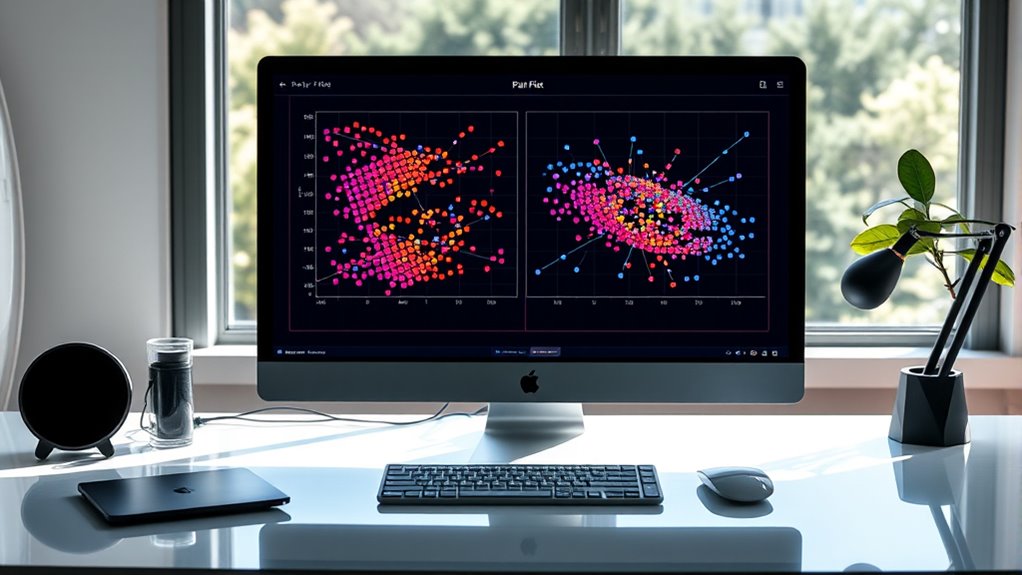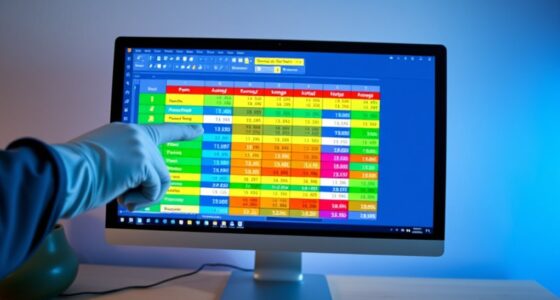Pair plots are a powerful way to explore multiple variables at once, helping you see relationships through scatterplots and distributions on the diagonal. They let you quickly identify correlations, patterns, outliers, and clusters within your data, giving you an extensive view in a single chart. Visual insights complement statistical measures and make complex data easier to interpret. Keep exploring to discover how this tool can enhance your analysis and decision-making capabilities.
Key Takeaways
- Pair plots visualize relationships between multiple variables simultaneously, highlighting correlations, patterns, and potential anomalies.
- They consist of a matrix of scatterplots for each variable pair, with histograms or density plots on the diagonals.
- Strong positive correlations appear as tight clusters along a line, while dispersed points indicate weak or no correlation.
- Useful in exploratory data analysis to detect data patterns, outliers, and complex interactions before modeling.
- Customizable with colors, sizes, and overlays, pair plots enhance multidimensional understanding in a single, interpretable chart.

Pair plots are powerful visualization tools that help you explore relationships between multiple variables in a dataset. When you’re analyzing complex data, understanding how variables relate to each other is essential. Pair plots make this process straightforward by displaying scatterplots for every possible variable pair within your dataset. This all-encompassing view allows you to quickly identify patterns, trends, and potential correlations, especially variable correlation, which is vital for building accurate models or drawing meaningful insights.
Pair plots reveal relationships and correlations among multiple variables in your dataset.
One of the main advantages of pair plots is their ability to serve as a form of multivariate visualization. Instead of examining variables individually, you see how they interact in pairs, providing a multidimensional perspective in a single, easy-to-interpret chart. This is particularly useful when you’re dealing with datasets containing several variables, as it helps you spot relationships that might not be obvious through summary statistics alone. For instance, you might notice a strong positive correlation between two variables, or perhaps a more complex, nonlinear relationship that warrants further investigation.
When creating a pair plot, you typically select your variables of interest, and the tool generates a matrix of scatterplots. The diagonal usually displays the distribution of individual variables, such as histograms or density plots, giving you insight into their shape and spread. The off-diagonal plots show how each pair of variables relates, enabling you to visually assess the strength and direction of correlations. If you observe tightly clustered points along a line, it suggests a strong correlation; if the points are more dispersed, the relationship might be weaker or non-existent. Additionally, understanding the contrast ratio of a projector can help you better interpret visual data quality, which is essential in creating effective visualizations.
Pair plots are especially effective in exploratory data analysis because they provide a quick overview of your dataset’s structure. You can detect outliers, clusters, and anomalies that might influence your analysis or modeling efforts. Furthermore, these plots allow you to compare multiple variables simultaneously, saving time and effort compared to creating individual scatterplots or correlation matrices. They’re also adaptable—by customizing colors, sizes, and overlays, you can highlight specific data points or categories, making your multivariate visualization even more informative.
Frequently Asked Questions
How Can Pair Plots Improve My Data Analysis Workflow?
Pair plots can substantially enhance your data analysis workflow by visually revealing relationships between features, aiding in dimensional reduction and feature selection. They help you identify correlations, outliers, or patterns that might be hidden in raw data. By quickly evaluating multiple variable interactions, you can streamline your feature engineering process, focus on the most relevant features, and make more informed decisions, ultimately saving time and improving your model’s accuracy.
Are Pair Plots Suitable for High-Dimensional Datasets?
If you’re working with high-dimensional datasets, pair plots might not be ideal without dimensionality reduction. They can become cluttered and less effective as the number of variables increases, impacting plot scalability. To make them useful, you should apply techniques like PCA or t-SNE to reduce dimensions first. This way, pair plots can reveal meaningful relationships without overwhelming you with too much information.
What Are Common Pitfalls When Interpreting Pair Plots?
When interpreting pair plots, you should watch out for common pitfalls like overplotting, which can obscure data patterns, and misinterpretation of correlations, leading you to draw false conclusions. Overplotting occurs when too many data points overlap, making it hard to see true relationships. Always consider using transparency or sampling to reduce clutter, and avoid jumping to assumptions without checking the context of the visualized relationships.
How Do I Customize Pair Plot Visuals for Better Clarity?
To customize pair plot visuals for better clarity, start by selecting appropriate color schemes that differentiate variables clearly. You can also customize markers—adjust size, shape, and transparency—to make data points more distinguishable. These tweaks help you quickly interpret relationships and spot patterns. Using consistent colors and markers across plots guarantees clarity, making your data visualization more effective and easier to understand at a glance.
Can Pair Plots Be Used With Non-Numeric Data?
You can’t directly use pair plots with non-numeric data because they mainly visualize relationships between numerical variables. However, for categorical visualization, you can convert non-numeric variables into numeric form using techniques like encoding. Alternatively, consider using other visualization tools like bar plots or heatmaps for categorical data. These methods help you explore non-numeric variables effectively, complementing pair plots’ insights when working with mixed data types.
Conclusion
Now that you’ve uncovered the secrets of pair plots, you’ll wonder how you ever analyzed data without them. These visual powerhouses turn complex datasets into crystal-clear stories in seconds—saving you hours of guesswork. With pair plots in your toolkit, you’ll access insights faster than you can say “correlation,” transforming your data game forever. Get ready to conquer mountains of data with a single chart—because once you see their magic, there’s no going back!










